话不多说,直接上步骤代码。
由于在windows下进行springboot整合redis,所以需要下载redis(),下载好后解压一下,执行redis-server,执行完毕redis启动,可以再下载一个redis可视化工具RedisDesktopManager
redis下载地址:https://github.com/MicrosoftArchive/redis/tags
下载完成安装后,cmd进入安装目录
执行redis-server.exe redis.windows.conf
我的执行后出现如下提示,说明安装未成功
![]()
随后按照下面步骤执行,分别执行redis-cli.exe, shutdown, exit

最后再执行redis-server.exe redis.windows.conf,出现如下界面,表示redis启动成功
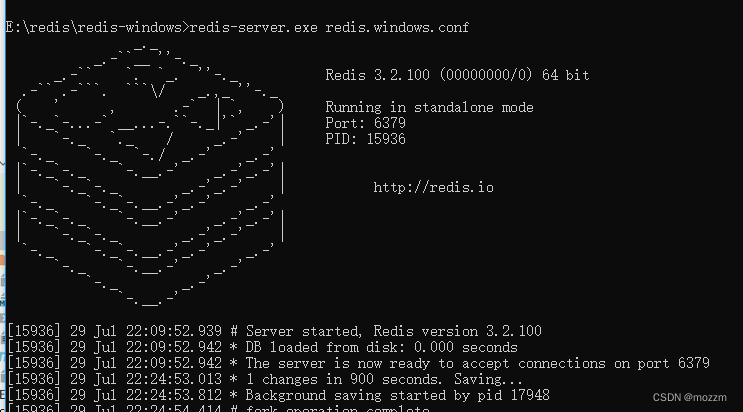
安装redis可视化工具redisdesktopmanager: https://github.com/uglide/RedisDesktopManager/releases/tag/0.9.3
打开redisdesktopmanager
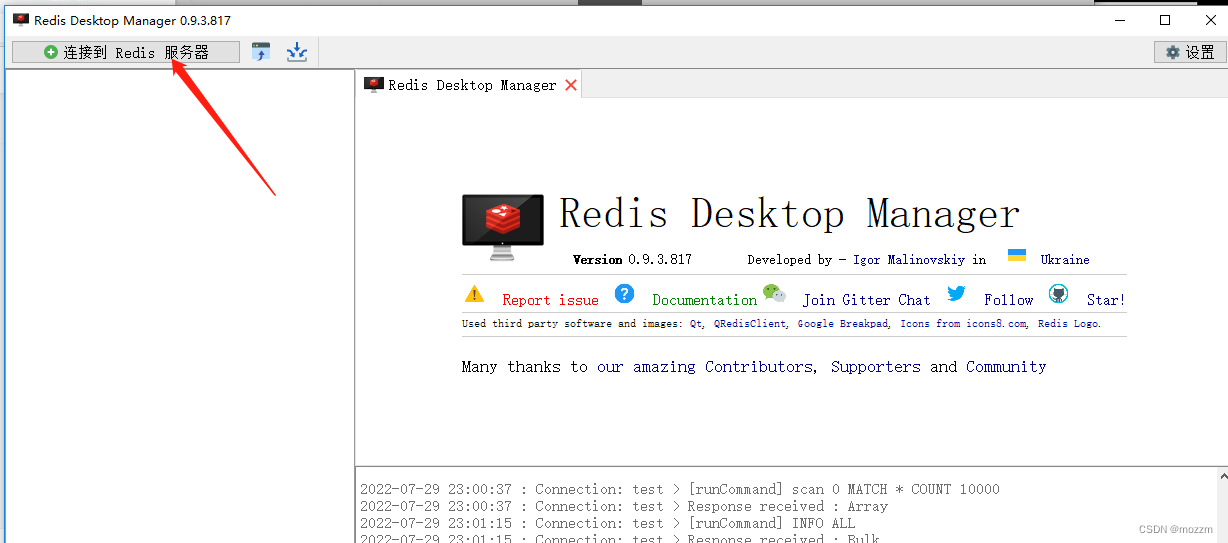
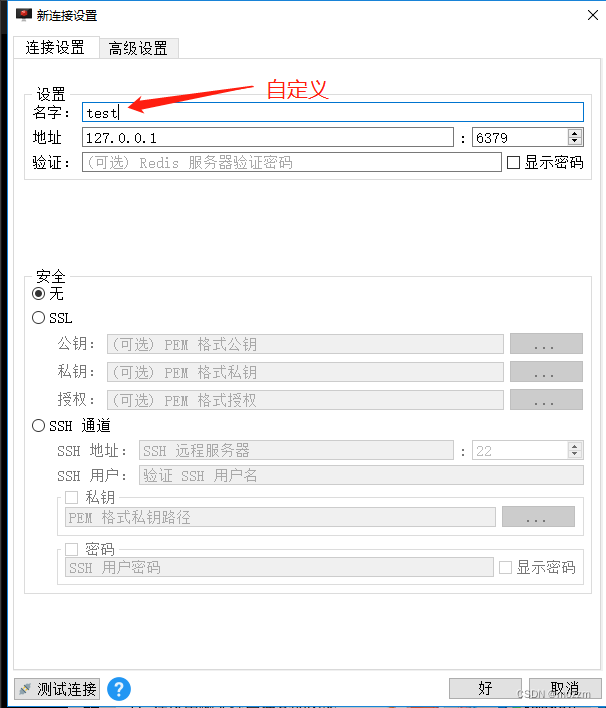
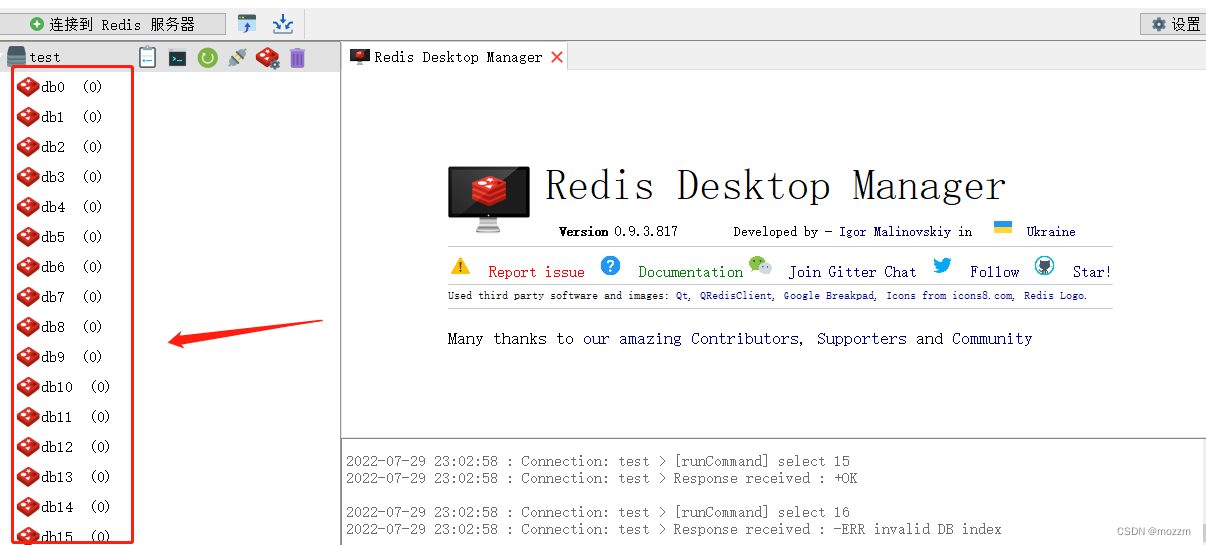
出现如下界面表示连接成功。
1. 在开始项目之前,我们需要自己创建一个数据库dbtest(自己随意命名,但是要注意下面yml配置中的url里面的数据库要跟这个名字对应), 然后在对应的数据库中创建一个表emp(自己命名),并且随便插入三条数据。
CREATE TABLE emp (
id INT PRIMARY KEY AUTO_INCREMENT,
`name` VARCHAR(100),
age INT
) ENGINE = INNODB DEFAULT CHARSET=utf8;
INSERT INTO emp(`name`,age) VALUES ('张三','18');
INSERT INTO emp(`name`,age) VALUES ('李四','19');
INSERT INTO emp(`name`,age) VALUES ('王五','20');
2.直接创建一个springboot项目,添加相关依赖(包含):web, mysql, redis, mybatis, lombok等
<?xml version="1.0" encoding="UTF-8"?>
<project xmlns="http://maven.apache.org/POM/4.0.0" xmlns:xsi="http://www.w3.org/2001/XMLSchema-instance"
xsi:schemaLocation="http://maven.apache.org/POM/4.0.0 https://maven.apache.org/xsd/maven-4.0.0.xsd">
<modelVersion>4.0.0</modelVersion>
<parent>
<groupId>org.springframework.boot</groupId>
<artifactId>spring-boot-starter-parent</artifactId>
<version>2.7.0</version>
<relativePath/> <!-- lookup parent from repository -->
</parent>
<groupId>com.example.mzz</groupId>
<artifactId>redis</artifactId>
<version>0.0.1-SNAPSHOT</version>
<name>redis</name>
<description>Demo project for Spring Boot</description>
<properties>
<java.version>1.8</java.version>
</properties>
<dependencies>
<dependency>
<groupId>org.springframework.boot</groupId>
<artifactId>spring-boot-starter-data-redis</artifactId>
</dependency>
<dependency>
<groupId>org.springframework.boot</groupId>
<artifactId>spring-boot-starter-web</artifactId>
</dependency>
<dependency>
<groupId>mysql</groupId>
<artifactId>mysql-connector-java</artifactId>
<scope>runtime</scope>
</dependency>
<dependency>
<groupId>org.projectlombok</groupId>
<artifactId>lombok</artifactId>
<optional>true</optional>
</dependency>
<dependency>
<groupId>org.springframework.boot</groupId>
<artifactId>spring-boot-starter-test</artifactId>
<scope>test</scope>
</dependency>
<dependency>
<groupId>org.apache.commons</groupId>
<artifactId>commons-pool2</artifactId>
</dependency>
<dependency>
<groupId>org.mybatis.spring.boot</groupId>
<artifactId>mybatis-spring-boot-starter</artifactId>
<version>2.2.2</version>
</dependency>
<dependency>
<groupId>tk.mybatis</groupId>
<artifactId>mapper-spring-boot-starter</artifactId>
<version>2.1.5</version>
</dependency>
</dependencies>
<build>
<plugins>
<plugin>
<groupId>org.springframework.boot</groupId>
<artifactId>spring-boot-maven-plugin</artifactId>
<configuration>
<excludes>
<exclude>
<groupId>org.projectlombok</groupId>
<artifactId>lombok</artifactId>
</exclude>
</excludes>
</configuration>
</plugin>
</plugins>
</build>
</project>
添加完依赖后配置yml文件:包括端口号,mysql,redis, mybatis以及log日志
server:
port: 8888
#mysql
spring:
datasource:
username: root
password: root
url: jdbc:mysql://127.0.0.1:3306/dbtest?useUnicode=true&characterEncoding=utf-8&useSSL=false&serverTimezone=GMT
driver-class-name: com.mysql.cj.jdbc.Driver
#redis
redis:
host: localhost
port: 6379
timeout: 1000
jedis:
pool:
min-idle: 5
max-idle: 10
max-wait: -1
mybatis:
mapper-locations: classpath*:/mapper/**/*.xml
type-aliases-package: com.example.redis.entities
configuration:
map-underscore-to-camel-case: true
logging:
level:
com.example.redis: debug
到此依赖以及配置都完成,接下来创建entities实体类,mapper,service,controller
(1)创建实体(j结合lombok注解)
package com.example.redis.entities;
import lombok.Data;
import javax.persistence.GeneratedValue;
import javax.persistence.GenerationType;
import javax.persistence.Id;
import javax.persistence.Table;
import java.io.Serializable;
@Data
@Table(name = "emp")
public class Emp implements Serializable {
@Id
@GeneratedValue(strategy = GenerationType.IDENTITY)
private Integer id;
private String name;
private Integer age;
}
(2)创建mapper(EmpMapper):这里继承通用Mapper,代替开发人员对单表的增删改查,不需要再写增删改查的sql了。
package com.example.redis.mapper;
import com.example.redis.entities.Emp;
import tk.mybatis.mapper.common.Mapper;
public interface EmpMapper extends Mapper<Emp> {
}
(3)创建service(接口中写了一个id获取对象的方法,大家有兴趣可以把增删改查方法都写上,这些都是基础,就不做过多介绍了)
package com.example.redis.service;
import com.example.redis.entities.Emp;
public interface EmpService {
//根据id获取
public Object getEmpById(Integer id);
}
(3)创建config
package com.example.redis.config;
import org.springframework.context.annotation.Bean;
import org.springframework.context.annotation.Configuration;
import org.springframework.data.redis.connection.RedisConnectionFactory;
import org.springframework.data.redis.core.RedisTemplate;
import org.springframework.data.redis.serializer.Jackson2JsonRedisSerializer;
import org.springframework.data.redis.serializer.StringRedisSerializer;
@Configuration
public class RedisConfig {
@Bean
public RedisTemplate<String,Object> redisTemplate(RedisConnectionFactory factory){
RedisTemplate<String,Object> redisTemplate = new RedisTemplate<>();
redisTemplate.setConnectionFactory(factory);
//指定kv序列化
Jackson2JsonRedisSerializer jackson2JsonRedisSerializer = new Jackson2JsonRedisSerializer(Object.class);
// redisTemplate.setDefaultSerializer(jackson2JsonRedisSerializer);
//键值分别采用不同的序列化方式
redisTemplate.setValueSerializer(jackson2JsonRedisSerializer);
redisTemplate.setKeySerializer(new StringRedisSerializer());
return redisTemplate;
}
}
配置中可以对不同的键值分别采用不同的序列化方式,比如StringRedisSerializer就可以得到String类型的
(4)创建service的实现类
package com.example.redis.service.Impl;
import com.example.redis.entities.Emp;
import com.example.redis.mapper.EmpMapper;
import com.example.redis.service.EmpService;
import org.springframework.beans.factory.annotation.Autowired;
import org.springframework.data.redis.core.RedisTemplate;
import org.springframework.stereotype.Service;
@Service
public class EmpServiceImpl implements EmpService {
@Autowired
private RedisTemplate redisTemplate;
@Autowired
private EmpMapper empMapper;
@Override
public Object getEmpById(Integer id) {
String key = "userId:"+id;
//从缓存中获取
Object obj = redisTemplate.opsForValue().get(key);
/*
1.首先判断缓存中是否有值,有的话直接从缓存中获取
2.缓存中没有则从数据库中获取,并且将获取的结果存入缓存中,下次直接从缓存中取
*/
if(obj == null){
//没有值则从数据库中获取
Emp emp = empMapper.selectByPrimaryKey(id);
//存入缓存
redisTemplate.opsForValue().set(key,emp);
return emp;
}else{
}
return obj;
}
}
注意:redisTemplate是springboot访问RedisConnectionFactory对多种驱动进行集成,上层通过xxxOperations提供丰富的api,并结合Spring4基于泛型的bean注入,极大的提供了便利,成为日常开发的一大利器。
关于opsForValue的用法,具体可以参考这篇博客:https://blog.csdn.net/qq_25135655/article/details/80357137
当我们获取值的时候,先从缓存中取,缓存中有就直接取,没有的话再去数据库中取。一般像电商某个产品点击量比较大,不可能每次都从数据库获取,这样也可能会导致数据库扛不住,所以这时候就可以用缓存。
(5)最后创建controller
package com.example.redis.controller;
import com.example.redis.service.EmpService;
import org.springframework.beans.factory.annotation.Autowired;
import org.springframework.data.redis.core.RedisTemplate;
import org.springframework.web.bind.annotation.GetMapping;
import org.springframework.web.bind.annotation.PathVariable;
import org.springframework.web.bind.annotation.RequestMapping;
import org.springframework.web.bind.annotation.RestController;
@RestController
@RequestMapping("/emp")
public class EmpController {
@Autowired
private EmpService empService;
@GetMapping("/getEmp/{id}")
public Object getEmpById(@PathVariable("id") Integer id){
return empService.getEmpById(id);
}
}
启动类:
package com.example.redis;
import org.springframework.boot.SpringApplication;
import org.springframework.boot.autoconfigure.SpringBootApplication;
import tk.mybatis.spring.annotation.MapperScan;
@SpringBootApplication
@MapperScan("com.example.redis.mapper")
public class RedisApplication {
public static void main(String[] args) {
SpringApplication.run(RedisApplication.class, args);
}
}
运行项目:

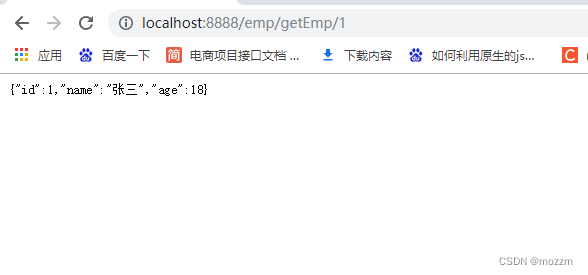
能够正常获取到值,通过查看日志可以看到是通过数据库获取到的,这是因为原先的缓存中没有记录

执行http://localhost:8888/emp/getEmp/1请求后从数据库获取到数据,会保存到缓存中,通过redisdeskmanager查看:

这时里面会有记录。
此时清空控制台日志,再次执行http://localhost:8888/emp/getEmp/1请求,可以看到此时的控制台不会出现数据库信息,这是因为此时获取的值都是从缓存中获取到的。

当然,对于上述实现现在都可以通过注解的方式来实现,redis主要涉及这样几个注解: @EnableCaching,@Cacaheable,@CacaheEvict,@CachePut以及@Caching等
在启动类上我们需要加上@EnableCaching注解,@EnableCaching注解是spring framework中的注解驱动的缓存管理功能。自spring版本3.1起加入了该注解。如果你使用了这个注解,那么你就不需要在xml文件中配置cache manager了。
上述启动类修改:
package com.example.redis;
import org.springframework.boot.SpringApplication;
import org.springframework.boot.autoconfigure.SpringBootApplication;
import org.springframework.cache.annotation.EnableCaching;
import tk.mybatis.spring.annotation.MapperScan;
@SpringBootApplication
@MapperScan("com.example.redis.mapper")
@EnableCaching
public class RedisApplication {
public static void main(String[] args) {
SpringApplication.run(RedisApplication.class, args);
}
}
config配置文件修改:
package com.example.redis.config;
import com.fasterxml.jackson.annotation.JsonAutoDetect;
import com.fasterxml.jackson.annotation.PropertyAccessor;
import com.fasterxml.jackson.databind.ObjectMapper;
import org.springframework.cache.CacheManager;
import org.springframework.cache.annotation.CachingConfigurerSupport;
import org.springframework.cache.annotation.EnableCaching;
import org.springframework.context.annotation.Bean;
import org.springframework.context.annotation.Configuration;
import org.springframework.data.redis.cache.RedisCacheConfiguration;
import org.springframework.data.redis.cache.RedisCacheManager;
import org.springframework.data.redis.connection.RedisConnectionFactory;
import org.springframework.data.redis.core.RedisTemplate;
import org.springframework.data.redis.serializer.Jackson2JsonRedisSerializer;
import org.springframework.data.redis.serializer.RedisSerializationContext;
import org.springframework.data.redis.serializer.RedisSerializer;
import org.springframework.data.redis.serializer.StringRedisSerializer;
import java.time.Duration;
@EnableCaching //开启缓存
@Configuration
public class RedisConfig extends CachingConfigurerSupport {
@Bean
public RedisTemplate<String, Object> redisTemplate(RedisConnectionFactory factory) {
RedisTemplate<String, Object> template = new RedisTemplate<>();
RedisSerializer<String> redisSerializer = new StringRedisSerializer();
Jackson2JsonRedisSerializer jackson2JsonRedisSerializer = new Jackson2JsonRedisSerializer(Object.class);
ObjectMapper om = new ObjectMapper();
om.setVisibility(PropertyAccessor.ALL, JsonAutoDetect.Visibility.ANY);
om.enableDefaultTyping(ObjectMapper.DefaultTyping.NON_FINAL);
jackson2JsonRedisSerializer.setObjectMapper(om);
template.setConnectionFactory(factory);
//key序列化方式
template.setKeySerializer(redisSerializer);
//value序列化
template.setValueSerializer(jackson2JsonRedisSerializer);
//value hashmap序列化
template.setHashValueSerializer(jackson2JsonRedisSerializer);
return template;
}
@Bean
public CacheManager cacheManager(RedisConnectionFactory factory) {
RedisSerializer<String> redisSerializer = new StringRedisSerializer();
Jackson2JsonRedisSerializer jackson2JsonRedisSerializer = new Jackson2JsonRedisSerializer(Object.class);
//解决查询缓存转换异常的问题
ObjectMapper om = new ObjectMapper();
om.setVisibility(PropertyAccessor.ALL, JsonAutoDetect.Visibility.ANY);
om.enableDefaultTyping(ObjectMapper.DefaultTyping.NON_FINAL);
jackson2JsonRedisSerializer.setObjectMapper(om);
// 配置序列化(解决乱码的问题),过期时间600秒
RedisCacheConfiguration config = RedisCacheConfiguration.defaultCacheConfig()
.entryTtl(Duration.ofSeconds(600)) //设置数据过期时间600秒
.serializeKeysWith(RedisSerializationContext.SerializationPair.fromSerializer(redisSerializer))
.serializeValuesWith(RedisSerializationContext.SerializationPair.fromSerializer(jackson2JsonRedisSerializer))
.disableCachingNullValues();
RedisCacheManager cacheManager = RedisCacheManager.builder(factory)
.cacheDefaults(config)
.build();
return cacheManager;
}
}
//package com.example.redis.config;
//
//import org.springframework.cache.annotation.CachingConfigurerSupport;
//import org.springframework.context.annotation.Bean;
//import org.springframework.context.annotation.Configuration;
//import org.springframework.data.redis.connection.RedisConnectionFactory;
//import org.springframework.data.redis.core.RedisTemplate;
//import org.springframework.data.redis.serializer.Jackson2JsonRedisSerializer;
//import org.springframework.data.redis.serializer.StringRedisSerializer;
//
//@Configuration
//public class RedisConfig extends CachingConfigurerSupport {
//
// @Bean
// public RedisTemplate<String,Object> redisTemplate(RedisConnectionFactory factory){
// RedisTemplate<String,Object> redisTemplate = new RedisTemplate<>();
// redisTemplate.setConnectionFactory(factory);
//
// //指定kv序列化
// Jackson2JsonRedisSerializer jackson2JsonRedisSerializer = new Jackson2JsonRedisSerializer(Object.class);
redisTemplate.setDefaultSerializer(jackson2JsonRedisSerializer);
// //键值分别采用不同的序列化方式
// redisTemplate.setValueSerializer(jackson2JsonRedisSerializer);
// redisTemplate.setKeySerializer(new StringRedisSerializer());
//
// return redisTemplate;
// }
//
//}
EmpserviceImpl修改:
package com.example.redis.service.Impl;
import com.example.redis.entities.Emp;
import com.example.redis.mapper.EmpMapper;
import com.example.redis.service.EmpService;
import org.springframework.beans.factory.annotation.Autowired;
import org.springframework.data.redis.core.RedisTemplate;
import org.springframework.stereotype.Service;
@Service
public class EmpServiceImpl implements EmpService {
@Autowired
private RedisTemplate redisTemplate;
@Autowired
private EmpMapper empMapper;
@Override
public Object getEmpById(Integer id) {
// String key = "userId:"+id;
//
// //从缓存中获取
// Object obj = redisTemplate.opsForValue().get(key);
//
// /*
// 1.首先判断缓存中是否有值,有的话直接从缓存中获取
// 2.缓存中没有则从数据库中获取,并且将获取的结果存入缓存中,下次直接从缓存中取
// */
// if(obj == null){
// //没有值则从数据库中获取
// Emp emp = empMapper.selectByPrimaryKey(id);
// //存入缓存
// redisTemplate.opsForValue().set(key,emp);
// return emp;
// }else{
//
// }
// return obj;
return empMapper.selectByPrimaryKey(id);
}
}
controller修改
Cacheable注解:相当于执行该方法时,会先去缓存中查找,查找不到再去数据库中查找,然后再将该值存入到缓存中以便下次使用。
package com.example.redis.controller;
import com.example.redis.service.EmpService;
import lombok.extern.slf4j.Slf4j;
import org.springframework.beans.factory.annotation.Autowired;
import org.springframework.cache.annotation.Cacheable;
import org.springframework.data.redis.core.RedisTemplate;
import org.springframework.web.bind.annotation.GetMapping;
import org.springframework.web.bind.annotation.PathVariable;
import org.springframework.web.bind.annotation.RequestMapping;
import org.springframework.web.bind.annotation.RestController;
@RestController
@RequestMapping("/emp")
public class EmpController {
@Autowired
private EmpService empService;
@GetMapping("/getEmp/{id}")
@Cacheable(value = "userid")
public Object getEmpById(@PathVariable("id") Integer id){
return empService.getEmpById(id);
}
}
启动后,可以看到缓存中没有数据,执行后从数据库获取到数据

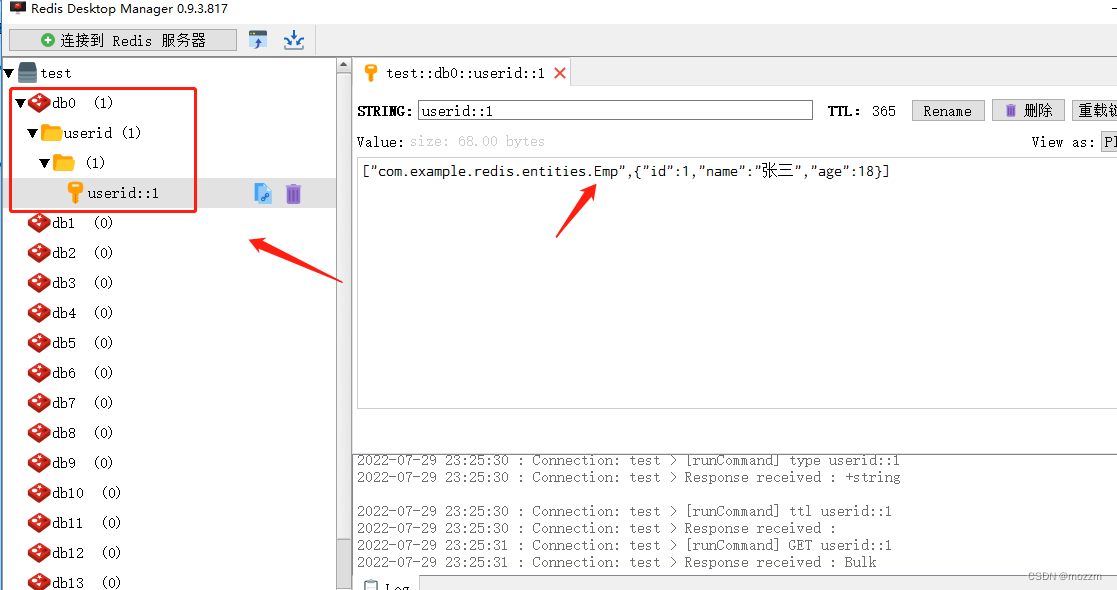
可以看到,利用注解得到的结果与上述通过redisTemplate得到的结果是一致的,所以对于缓存可以通过注解实现,简单方便。
还有其他注解后续有时间再更。






















 907
907











 被折叠的 条评论
为什么被折叠?
被折叠的 条评论
为什么被折叠?










